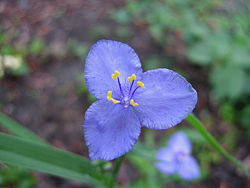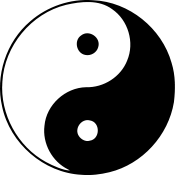Rotational Symmetry
K-12: Materials at high school level.
A shape with rotational symmetry is a shape that looks the same even if you turn the shape around a little bit. Another way to think about rotational symmetry is to notice in the following examples how we see several copies arranged around a central point.
Below the Spiderwort flower for instance has three leaves arranged around the center of the flower. The Spiderwort has 3-fold rotational symmetry (120 degrees). The baby starfish has 4 legs arranged around the center of the body. This baby starfish has 4-fold rotational symmetry (90 degrees) The red knobbed starfish shown here has five equally spaced legs. It has 5-fold rotational symmetry (72 degrees). The Clematis shown has 8-fold rotational symmetry (45 degrees). It has 8 flower petals arranged around the center of the flower. The top left flower in the bunch is the one where the number of petals is most easily seen.
 |
 |

|
| Spiderwort | Baby starfish | Red knobbed starfish |
 |
 |

|
| Clematis | Chemistry | Yin-Yang symbol |
The benzene molecule is interesting. It almost has 6-fold rotational symmetry, but if you look closely you will notice that the two models on the left have some single lines in there that tusn it into 3-fold symmetry. The picture with the circle in the center really does have 6 fold symmetry. These symmetries play an important role in the advanced study of chemistry.
The Yin-yang symbol is included here to show you that colors used in an image may play a role. If we ignore the fact that one side is black and the other is white, then this image has 2-fold rotational symmetry. If we do look at the colors, the symbol does not have rotational symmetry. Some people would say that the yin-yang symbol has 2-fold rotational symmetry, but has no color rotational symmetry. In our discussions of patterns and their symmetry we tend to ignore the colors used.
To be a bit more precise we will use the following terminology.
If points on a figure are equally positioned about a central point, then we say the object has rotational symmetry. A figure with rotational symmetry appears the same after rotating by some amount around the center point.

The angle of rotation of a symmetric figure is the smallest angle of rotation that preserves the figure. For example, the figure on the left can be turned by 180° (the same way you would turn an hourglass) and will look the same. The center (recycle) figure can be turned by 120°, and the star can be turned by 72°. For the star, where did 72° come from? The star has five points. To rotate it until it looks the same, you need to make of a complete 360° turn. Since , this is a 72° angle rotation.
Using degrees to describe the rotation amount is inconvenient because the precise angle is not obvious from looking at the figure. Instead, we will almost always use the order of rotation to describe rotational symmetry:
Order of rotation : A figure has order n rotational symmetry if 1/n of a complete turn leaves the figure unchanged. Another way to say this is that the figure has n-fold rotational symmetry.
You can compute the angle of rotation from the order of rotation:
An order n rotation corresponds to a angle of rotation.
You can check for instance that with the Spiderwort flower we have an order 3 rotation (also called 3-fold rotation), and the angle of rotation would be computed by taking 360 and dividing it by 3:



